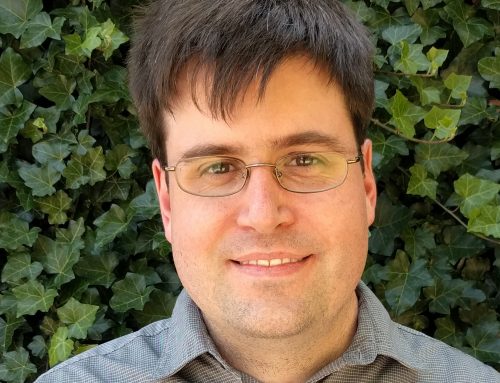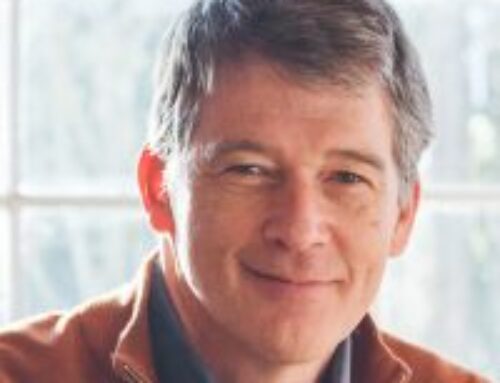Art can be powerful. History and common human experience witness to this fact. My experience witnesses to this fact. Recently, in a mind-bending Bible study about the first-century culture of the apostles and Jesus, we discussed how Peter and Paul must have felt themselves to be very ordinary, unworthy humans given an “impossible” task by God: to take the Gospel to the corners of their world. Soon after that study, while I was relaxing with an image-filled journal on the work of Luc Tuymans (one of the most influential artists on the present world art scene), I came across a painting he had done of the apostles Peter and Paul.1 They were standing close to each other, staring in the same direction at something outside the picture frame that had captured their attention. I had never seen a painting quite like it. I can’t describe the painting adequately here, except to say that its images affected my frame of mind and attitude regarding the similar task the church has before it today: taking the gospel to the corners of our world.
This painting, in the most indescribable manner, evoked in me a profound empathy and sense of common calling with Peter and Paul. Somehow this work of art conveyed to me the unvarnished reality of the apostles’ utter humanness—with all its attending fear, frailty, and uncertainty—and their simultaneous unswerving commitment to the kingdom of God. This piece of art altered my sensibilities and spiritual conscience in the moment, provoking me to reflect on my life and identity as I strive to center it in the gospel.
Art’s Power in the World
Human artistry, with its uncanny power to shape human sensibilities, fascinates me. Art both causes and manifests silent explosions in the soul. Throughout all history, it has changed, reinforced, and frequently altered the ways people see their world. Though few of us would say, “Art has changed my life,” most of us can testify to one or more experiences when music, a movie, a novel, a poem, or a painting affected us deeply—the memory of which remains with us. The world would be a different place without Michelangelo’s Sistine Chapel frescos, Van Gogh’s Night Café, Bach’s St. Matthew Passion, Picasso’s Guernica, and Hollywood movies.
Today the arts constitute a dynamically influential, culture-creating-and-shaping power. Given the character and nature of our postmodern culture, art (primarily music, video, and cinema) generates a culture with the power to move, shape, and influence masses of people in ways we could not have imagined a hundred years ago. We have become a society where images and sound have a far greater impact than words in creating and defining our “styles of consciousness” and both the content and boundaries of our social-cultural dialogues. Hence, those who envision and create those images, sounds, movements, spaces, and fictions hold significant influence and power among us.
Mostly we think of art as being emotionally powerful, which it is, but art is also a material trace of deep human convictions, beliefs, and ideas—including the most complex philosophical and religious reflections. Art can embody, reflect, and enforce our most sophisticated and vital ideas and beliefs. We know how words and language convey beliefs. But how do the arts accomplish this? To answer that question, we must begin by briefly defining “art.”
What Is Art Anyway?
A most basic definition of art is this: human idea/belief/sensibility taking form. I think of art as the special human voice or language we call upon when communicating in ordinary ways seems insufficient or incapable of conveying our convictions and inner reflections. Art is our humanness speaking in ways that convey or evoke how we see ourselves and our world.
An art work is a reflective, responsive “statement” manifesting focused observations about man and the world as seen through the eyes, experience, and existential world/life view of the art maker. Let’s unpack this a bit:
- Art is a reflective response. We are creatures made for this earthly existence. We come to know the world and ourselves in it as our God-created intelligence confronts and interacts with the world and its inhabitants. We observe and “dialogue” with each other and the world, which is necessary both for survival and for discovering meaning in our lives. Art making emerges from this dialogue.
- Art is made from and about focused observations of ourselves and others in the world. Many of our observations can be largely unreflective; often intuitive, rote, mundane, and utilitarian, they serve to get us through the everydayness of our days. Art, however, comes from a second kind of human observing. When everydayness leaves us longing for a unique and abiding meaning and significance, we find ourselves searching for it through both the bric-a-brac and beauty of the world in which we are immersed. Our intense, focused observation yields the creative reflection manifest in art.
- Art, then, is formed “statement” created from focused observations. What I am calling “statements” can take various forms: language/words (poetry); pictures and images; objects (sculpture); sounds (music); body movements (dance). Art can take any form an artist thinks can effectively communicate his intention.
- Artful “statements” emerge from individuals, one-of-a-kind persons, created by God. Individual art makers translate their subjective interpretations and visions of life from their inarticulate, inner world into humanly recognizable forms. This translation process requires effort to crystallize and control the deep introspection the art maker fabricates into his art. George Steiner argues, “We lack the right word for the extreme energizing and governance of instinct, for the ordered enlistment of intuition, used by the artist” (Real Presences, p. 12).
The Language of Art
We must remember that all art is allusive or indirect—that is, by its nature, art “points to” or presents its subject in ways that call on us to engage in deciphering its meaning and message. The message or idea(s) in some art, especially traditional representational (mimetic) art, is more immediately accessible to a viewer. A landscape, a vase-and-flowers still life, or a portrait, for example, are what they appear to be; and the content or idea in the art is connected to those recognizable objects. These images are more likely to convey their subject or topic in a fairly obvious way.
Alternatively, highly expressionistic or abstract paintings and instrumental music convey their “messages” in much more allusive and indirect modes. We all know, however, that these less direct art forms can relay real content and psychological or emotional realities in very powerful ways. For example, Georges Rouault’s expressionist paintings and etchings of dark, humble, rebellious human characters evoke in us a profound empathy and understanding of the broken human condition. Earth-shattering melancholy and feelings of loss grip us as we hear Górecki’s Third Symphony.
In either representational or abstract modes, the artist uses the “language” of art (marks, sounds, movements, space, objects, etc.) to communicate ideas, feelings, and visions of life.
Art carries messages in ways similar to that of metaphor. A metaphor juxtaposes one mental picture with a second that is often unexpected or surprising, and the metaphor’s power results from the interplay between the two elements. For example, in Shakespeare’s famous balcony scene, Romeo says “Juliet is the sun.” Juxtaposing Juliet with an image of the sun associates her person, character, and human attributes with the sun’s attributes and creates a new, vibrant image of what Juliet means to Romeo. Thus the metaphor not only describes (in this example, Juliet, a pretty young woman), but it also creates a new picture—an imaginative integration that (1) describes in a new way, (2) carries idea/content through which one can gain fresh understanding, and (3) evokes intense emotional involvement while not excluding cognitive, propositional truth.2
Art operates in an analogous way. It “pictures” one or more images, objects, sounds, movements—the combination or character of which registers an impression, sensibility, or concept. The bundle of ordered thought and feelings found in metaphor and art is not irrational, yet it is irreducible to adequate description in words. All art operates in this way to carry its messages and content.
The Process of Making Art
At least two levels characterize the artist’s effort to make art. The first level is a composite of three essential components of a work of art: (1) the artist must competently control the craft of his medium; (2) he must seriously engage the historical development and “conversation” in his genre; and (3) he must meld both craft and grasp of his medium’s current philosophical/theoretical developments with his own vision of life. The effort to engage all three elements simultaneously forms the greatest challenge to anyone wishing to make successful, serious art.3
The second level of the artist’s effort takes a concept, sensibility, and/or belief and extrudes it through his creative imagination (conscious and subconscious, or tacit, intelligence). The artist then chooses a form (words, marks made with pigment, or other medium) that seems appropriate to his vision of the art piece.
Most of the time all of this happens in a “dialectic”—a back-and-forth inner dialogue between the artist’s conscious effort and his subconscious or intuitive effort. Often this process is a rather mysterious, inarticulate exploration. On one side, the artist explores, laying down thought forms in words, sounds, images, body movements, spaces, etc. On the other, the artist steps back and, using every fiber of intellection, assesses whether his last compositional edit or addition was successful or not.
As artists mature in their work, they become more sure-handed and able to judge their own success at accomplishing their artistic aims. Their grasp of themselves and their own artistic process matures (though much may remain tacit), allowing them to produce better, more powerful, successful work.
Inevitably, the human condition—mind and body—reveals itself in an artist’s body of work. The Bible teaches that genuine faith manifests itself in the choices and works of everyday living. Analogously, human art evidences thought and belief in the “action” or results of art making. Because this is true, art making loads the deep, subjective (invisible) realities of our humanness—ideas, feelings, beliefs—into physical/material (visible) forms.
How this all happens can be a bit mysterious. Artists will tell you, “I know a great deal about the development of a particular piece of art,” but they will also say, “How did I do it?!” Robert Henri argues, “A real artist’s work is a surprise to him or her” (The Art Spirit, p. 264).
In Conclusion
Art can “light fires” in us. If you have not experienced this power of art yourself, then perhaps you have a family member, a friend, or a child whose life is deeply affected by art or music or film. The work of all great art is to break into our lazy routines. Art’s messages can result in new conditions or motivations for thinking about being alive in this present world. It can be another voice to instruct us on the obligations of being human.
At its best, art is high intelligence. But it cannot be reduced to or encapsulated in propositional cognition alone. In his book Real Presences, George Steiner argues that art is an embodied “sign” pointing to the fact that man is made by a transcendent Creator. Great art steps beyond ordinary human communication and becomes a different, potent means for us to say things about ourselves, about our world, and about what might be true beyond this temporal, material existence.
Endnotes
1. You can view the Tuymans painting Petrus & Paulus (1998) online here: http://www.bamart.be/works/detail/nl/287. Back to text. 2. I am indebted to Jeremy Begbie’s treatment of the topic of art as metaphor in his book Voicing Creation’s Praise. Back to text. 3. For fuller discussion of what I mean by “serious art,” see my previous News & Views article “Christians and Serious Art” (June 2003). You can find it in the articles section of the Art Project website. Back to text.





